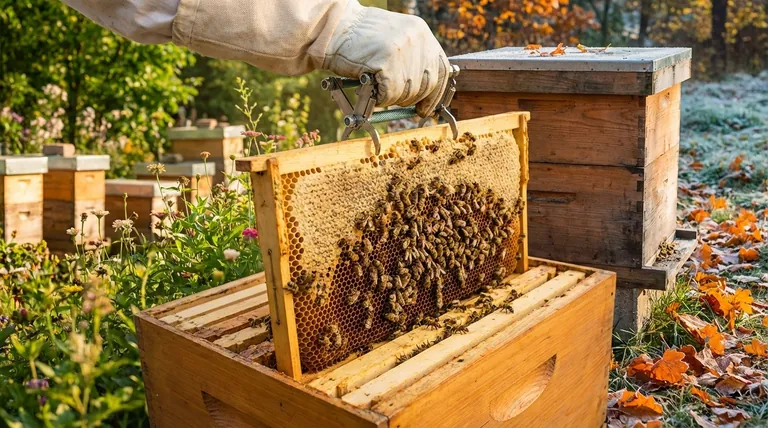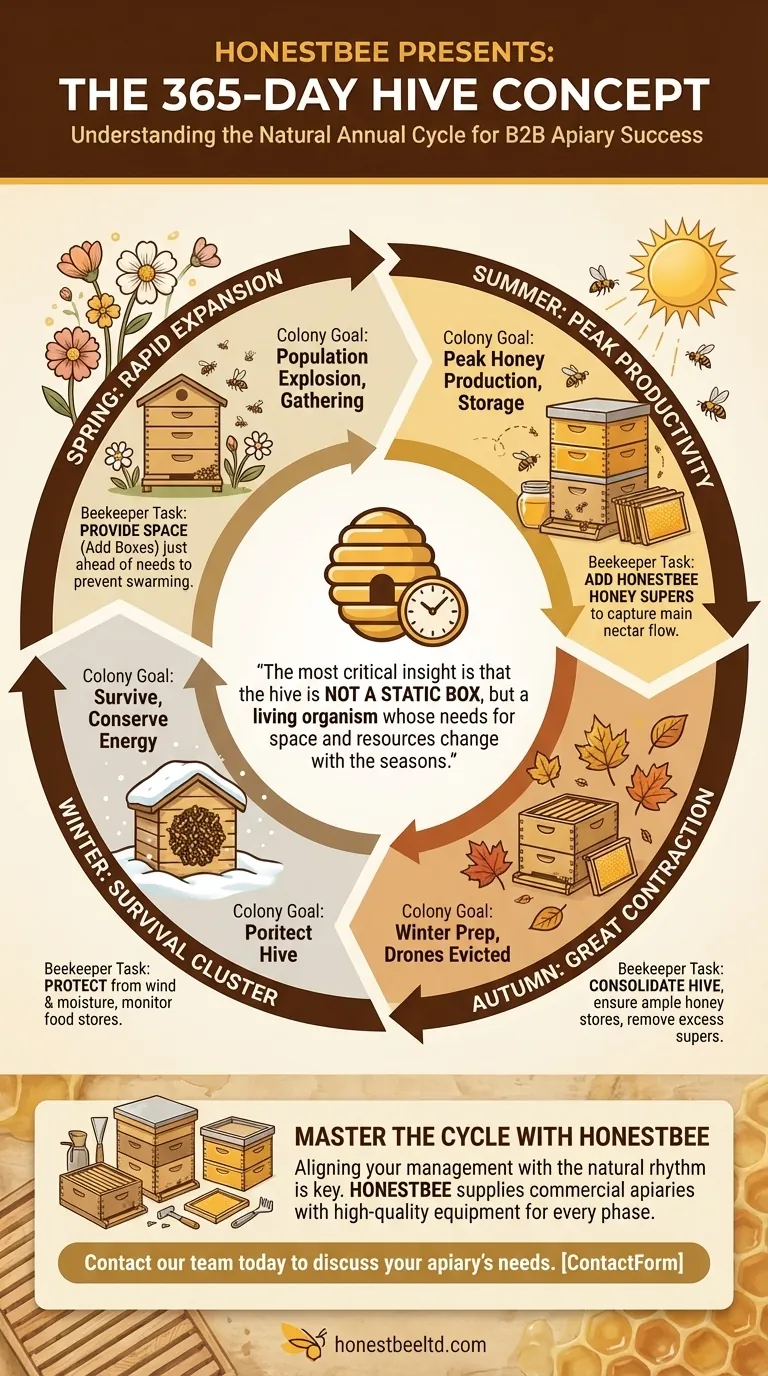At its core, the 365-day hive concept describes the natural annual cycle of a honey bee colony. It's a framework for understanding how a hive dynamically expands its physical space during the spring and summer nectar flows and contracts back to a smaller, more defensible size to survive the winter. This cycle dictates the beekeeper's primary management tasks throughout the year.
The most critical insight is that the hive is not a static box, but a living organism whose needs for space and resources change dramatically with the seasons. A successful beekeeper learns to anticipate and facilitate this natural rhythm of expansion and contraction.

The Seasonal Ebb and Flow of the Hive
Understanding the 365-day concept is about moving from a static view of the hive to a dynamic one. The colony's population, behavior, and spatial needs are in constant flux, driven entirely by the calendar and local environment.
Spring: The Period of Rapid Expansion
In early spring, the queen bee dramatically increases her rate of egg-laying. The colony's population explodes as new worker bees emerge, driven by the instinct to gather incoming pollen and nectar.
The beekeeper's primary job is to provide space just ahead of the bees' needs. This often involves adding a second brood box or the first honey super to prevent the hive from becoming "honey-bound" or "brood-bound," which are primary triggers for swarming.
Summer: The Peak of Productivity
By summer, the hive reaches its peak population and its largest physical size. This is the period of the main nectar flow, when bees are working tirelessly to collect and store honey.
During this phase, the hive might consist of two or three deep brood boxes and several additional honey supers stacked on top. The beekeeper's role shifts to monitoring hive health and adding more supers as needed to capture the honey surplus.
Autumn: The Great Contraction
As days shorten and temperatures cool, the nectar flow dwindles. The queen's egg-laying slows significantly, and the worker bees methodically evict the male drones, whose only purpose was to mate.
The hive's population begins to decline, and the beekeeper's focus turns to preparing for winter. This involves removing the surplus honey supers, ensuring the remaining boxes are full of honey for the bees, and consolidating the hive down to its winter configuration.
Winter: The Survival Cluster
In winter, the colony is at its smallest population and physical size, typically consisting of just two deep brood boxes. The remaining bees form a tight winter cluster around the queen to generate heat and conserve energy.
They survive by slowly consuming the honey they stored throughout the summer. The beekeeper's role is minimal, focused on protecting the hive from wind and moisture and ensuring the bees do not run out of their vital food stores.
Common Pitfalls in Hive Management
Aligning with the hive's natural cycle is crucial. Mis-timing your actions can create significant stress for the colony and undermine its success.
Providing Space Too Early
Adding supers in early spring before the colony has the population to manage it can be detrimental. The bees will struggle to patrol, defend, and maintain temperature in the oversized space, potentially chilling the vital brood.
Providing Space Too Late
This is the most common mistake leading to swarms. If the colony runs out of space for brood and honey, it will trigger its natural reproductive instinct to split, and you will lose half your bees and the old queen.
Harvesting Too Much Honey
In autumn, it is tempting to take as much honey as possible. However, removing too much leaves the colony with insufficient food stores to survive the long winter, leading to starvation.
Leaving Too Much Space for Winter
Failing to remove empty supers and consolidate the hive for winter is a critical error. An overly large space is difficult for the winter cluster to keep warm and can lead to condensation and moisture problems, which are deadly for bees.
Making the Right Choice for Your Goal
Your management strategy should always be guided by the colony's current needs, which are dictated by the season.
- If your primary focus is preventing swarms (Spring): Provide space just before the bees need it, ensuring the queen always has room to lay.
- If your primary focus is maximizing honey production (Summer): Stay ahead of the nectar flow by adding supers as soon as the previous one is about 70-80% full.
- If your primary focus is ensuring winter survival (Autumn): Consolidate the hive down to its core components and verify it has ample honey stores to last until spring.
Ultimately, the 365-day hive concept teaches you to work in partnership with your bees, facilitating the natural cycle they have perfected over millennia.
Summary Table:
| Season | Colony's Goal | Beekeeper's Key Task |
|---|---|---|
| Spring | Rapid Expansion | Provide space just ahead of needs to prevent swarming |
| Summer | Peak Honey Production | Add honey supers to capture the nectar flow |
| Autumn | Winter Preparation | Consolidate the hive and ensure ample honey stores |
| Winter | Survival | Protect the cluster from wind, moisture, and starvation |
Master the 365-day cycle with the right equipment.
Aligning your management with the natural rhythm of your hives is the key to a thriving apiary. This requires having the right supplies—from brood boxes to honey supers—at the right time.
HONESTBEE supplies commercial apiaries and beekeeping equipment distributors with the high-quality, durable supplies needed to support the hive through every season of its annual cycle. Our wholesale-focused operations ensure you get the equipment you need, when you need it.
Contact our team today to discuss your apiary's needs and ensure you're prepared for every phase of the 365-day hive concept.
Visual Guide

Related Products
- Professional 3-Bar Frame Grip with Integrated Hive Tool
- Professional Frame Comb Fork and Lifter for Efficient Handling
- Stainless Steel J Hook Hive Tool for Beekeeping
- HONESTBEE Professional Long Handled Hive Tool with Precision Cutting Blade
- HONESTBEE Advanced Ergonomic Stainless Steel Hive Tool for Beekeeping
People Also Ask
- What should beginners consider when purchasing beekeeping equipment? A Guide to Essential Starter Gear
- What is required to be a beekeeper? Essential Equipment, Knowledge & Mindset
- What does every bee keeper need? Your Essential Guide to Starting Strong
- What are the benefits of using Frame Grips in beekeeping? Boost Efficiency & Protect Your Hive
- What parts of bee equipment should be painted? A Guide to Protecting Your Hive and Your Bees



















